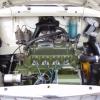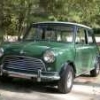
Ignition Timing...not Shoen In Haynes Manual
Started by
mk=john
, Oct 15 2010 12:06 PM
6 replies to this topic
#1

Posted 15 October 2010 - 12:06 PM
Hi
I need to set the dynamic timing of my mini. It is a very early mini, 848cc engine with the very early DM2 type distributor. I think these were used before 25D distributor
Anyway, my distributor type and serial number is not shown in the Haynes manual, and so i don't know what to set the dynamic timing to.
Anyway it says that using premium grade fuel, the dynamic timing should be 3 degrees BTDC. But this is showing a different distributor.
I am running leaded 4-star (at £1.85 / litre!!) which is premium grade as it has a high octane.
Would I be safe just setting the dynamic timing to 3 degrees?
Thanks
John
I need to set the dynamic timing of my mini. It is a very early mini, 848cc engine with the very early DM2 type distributor. I think these were used before 25D distributor
Anyway, my distributor type and serial number is not shown in the Haynes manual, and so i don't know what to set the dynamic timing to.
Anyway it says that using premium grade fuel, the dynamic timing should be 3 degrees BTDC. But this is showing a different distributor.
I am running leaded 4-star (at £1.85 / litre!!) which is premium grade as it has a high octane.
Would I be safe just setting the dynamic timing to 3 degrees?
Thanks
John
#2

Posted 15 October 2010 - 12:15 PM
My old Haynes says
9-15 @ 900
16-20 degrees at 1300rpm
24-28 @ 2500
30-34 @ 3400
for premium fuel dizzy: 40768 or 41026
9-15 @ 900
16-20 degrees at 1300rpm
24-28 @ 2500
30-34 @ 3400
for premium fuel dizzy: 40768 or 41026
#3

Posted 15 October 2010 - 12:20 PM
Thats what mine says, but my dizzy number is not shown as its a DM2 typeMy old Haynes says
9-15 @ 900
16-20 degrees at 1300rpm
24-28 @ 2500
30-34 @ 3400
for premium fuel dizzy: 40768 or 41026
#4

Posted 15 October 2010 - 12:27 PM
It's the correct advance you need more than the correct dizzy - why not plot it so you can compare the figures?
#5

Posted 16 October 2010 - 07:18 AM
It's the correct advance you need more than the correct dizzy - why not plot it so you can compare the figures?
Well, I've set the advance to 3 degrees BTDC, as shown in the manual fior premium fuel. As the fuel I am using is leaded 4-star.
I also used a colour tune, and this shows a bunsen blue flame when the engine is revved up, with an orangy-blue flame at idle.
The colour of the end of the spark plugs is a biscuit-brown colour, which I think is correct.
Shall I take it to a rolling road, or would it be a waste of money considering my findings as above?
Thanks
John
#6

Posted 16 October 2010 - 07:24 AM
In standard form, the A series can take a wide band of ignition timing without giving any trouble.
As long as you don't get 'pinking' under load, it should be fine. The real danger is over advancing under load when damage can be done. So, if you keep it slightly on the retarded side and slightly on the rich mixture side, all should be well.
Of course, if you want it spot on, a rolling road session will sort it out.
As long as you don't get 'pinking' under load, it should be fine. The real danger is over advancing under load when damage can be done. So, if you keep it slightly on the retarded side and slightly on the rich mixture side, all should be well.
Of course, if you want it spot on, a rolling road session will sort it out.
#7

Posted 16 October 2010 - 12:07 PM
John, Ado15's and Ethel's comments above were what I was going to mention.
The distributor's advance and the condition of your engine (and grade of your fuel) are what is important. I'm sure you have seen me suggest this before but I'll repeat it here anyway.
Use a static timing between 5-8 degrees BTDC just to get the engine started, then bring the engine to operating temperature. Use the fast idle screw to bring the engine speed up to 4000 RPM. Use an advance timing light to set the timing at 32 degrees, then return the engine to its normal idle speed. Test drive the car by placing it under heavy load (i.e. accelerating hard up hill in too high a gear). Listen for pinging or knocking. If you hear ANY, retard the timing in 2 degree steps and repeat the load test drive until no ugly sounds are heard. This method will set your timing to the maximum that the engine can accept based on its condition and the quality of fuel you use. Once this has been determined, you can measure the idle and/or static timing and record them for future use... eliminating the need for setting at 4000 RPM.
The distributor's advance and the condition of your engine (and grade of your fuel) are what is important. I'm sure you have seen me suggest this before but I'll repeat it here anyway.
Use a static timing between 5-8 degrees BTDC just to get the engine started, then bring the engine to operating temperature. Use the fast idle screw to bring the engine speed up to 4000 RPM. Use an advance timing light to set the timing at 32 degrees, then return the engine to its normal idle speed. Test drive the car by placing it under heavy load (i.e. accelerating hard up hill in too high a gear). Listen for pinging or knocking. If you hear ANY, retard the timing in 2 degree steps and repeat the load test drive until no ugly sounds are heard. This method will set your timing to the maximum that the engine can accept based on its condition and the quality of fuel you use. Once this has been determined, you can measure the idle and/or static timing and record them for future use... eliminating the need for setting at 4000 RPM.
1 user(s) are reading this topic
0 members, 1 guests, 0 anonymous users















